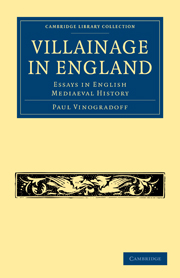Book contents
- Frontmatter
- PREFACE
- Contents
- INTRODUCTION
- FIRST ESSAY: THE PEASANTRY OF THE FEUDAL AGE
- SECOND ESSAY: THE MANOR AND THE VILLAGE COMMUNITY
- CHAPTER I THE OPEN FIELD SYSTEM AND THE HOLDINGS
- CHAPTER II RIGHTS OF COMMON
- CHAPTER III RURAL WORK AND RENTS
- CHAPTER IV THE LORD, HIS SERVANTS AND FREE TENANTS
- CHAPTER V THE MANORIAL COURTS
- CHAPTER VI THE MANOR AND THE VILLAGE COMMUNITY. CONCLUSIONS
- APPENDIX
- INDEX
CHAPTER II - RIGHTS OF COMMON
Published online by Cambridge University Press: 16 May 2011
- Frontmatter
- PREFACE
- Contents
- INTRODUCTION
- FIRST ESSAY: THE PEASANTRY OF THE FEUDAL AGE
- SECOND ESSAY: THE MANOR AND THE VILLAGE COMMUNITY
- CHAPTER I THE OPEN FIELD SYSTEM AND THE HOLDINGS
- CHAPTER II RIGHTS OF COMMON
- CHAPTER III RURAL WORK AND RENTS
- CHAPTER IV THE LORD, HIS SERVANTS AND FREE TENANTS
- CHAPTER V THE MANORIAL COURTS
- CHAPTER VI THE MANOR AND THE VILLAGE COMMUNITY. CONCLUSIONS
- APPENDIX
- INDEX
Summary
Meadows
The influence of the village community is especially apparent in respect of that portion of the soil which is used for the support of cattle. The management of meadows is very interesting because it presents a close analogy to the treatment of the arable, and at the same time the communal features are much more clearly brought out by it. We may take as an instance a description in the Eynsham Survey. The meadow in Shifford is divided into twelve strips, and these are distributed among the lord and the tenantry, but they are not apportioned to any one for constant ownership. One year the lord takes all the strips marked by uneven numbers, and the next year he moves to those distinguished by even numbers. The tenants divide the rest according to some settled rotation. Very often lots are drawn to indicate the portions of the several households. It must be added that the private right of the single occupiers does not extend over the whole year: as in the case of the arable all inclosures fall after the harvest, so in regard to meadows the separate use, and the boundaries protecting it, are upheld only till the mowing of the grass: after the removal of the hay the soil relapses into the condition of undivided land. The time of the ‘defence’ extends commonly to ‘Lammas day:’ hence the expression ‘Lammas-meadow’ to designate such land.
- Type
- Chapter
- Information
- Villainage in EnglandEssays in English Mediaeval History, pp. 259 - 277Publisher: Cambridge University PressPrint publication year: 2010First published in: 1892

